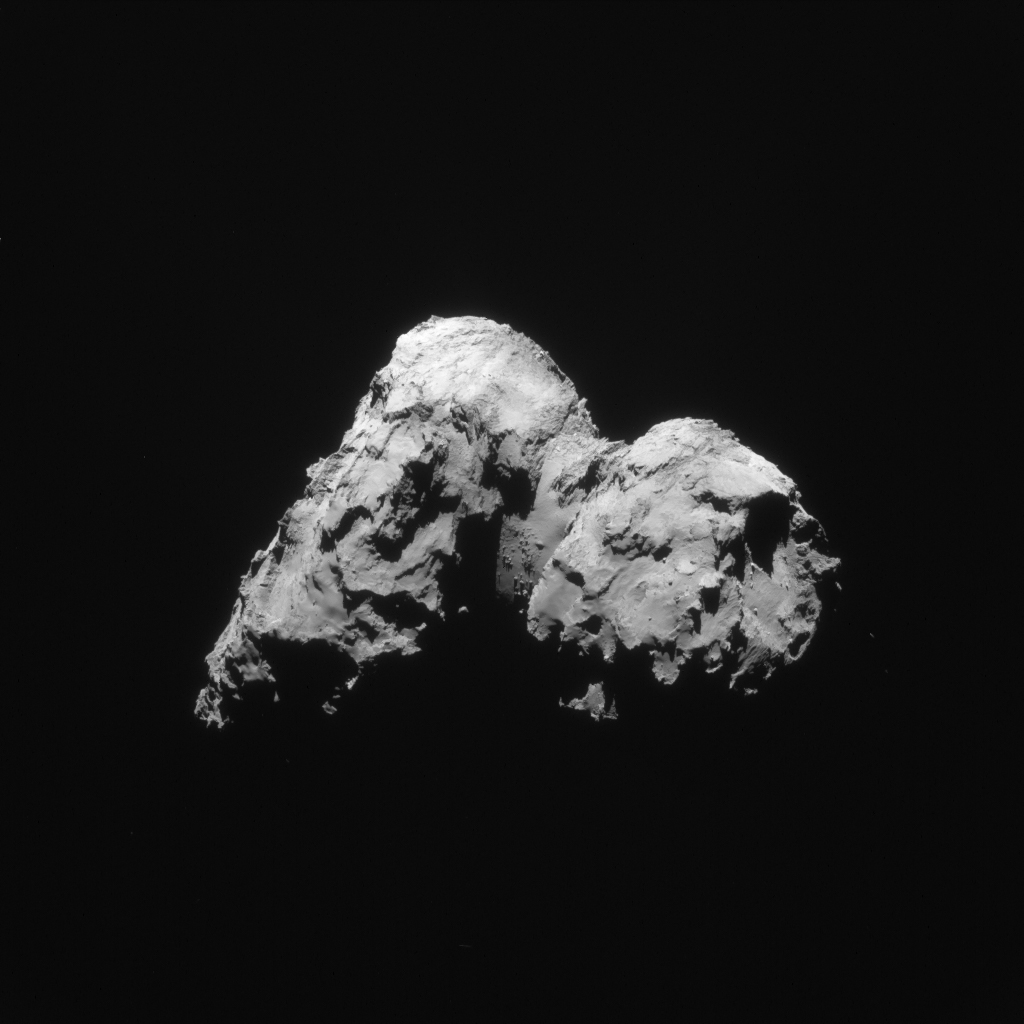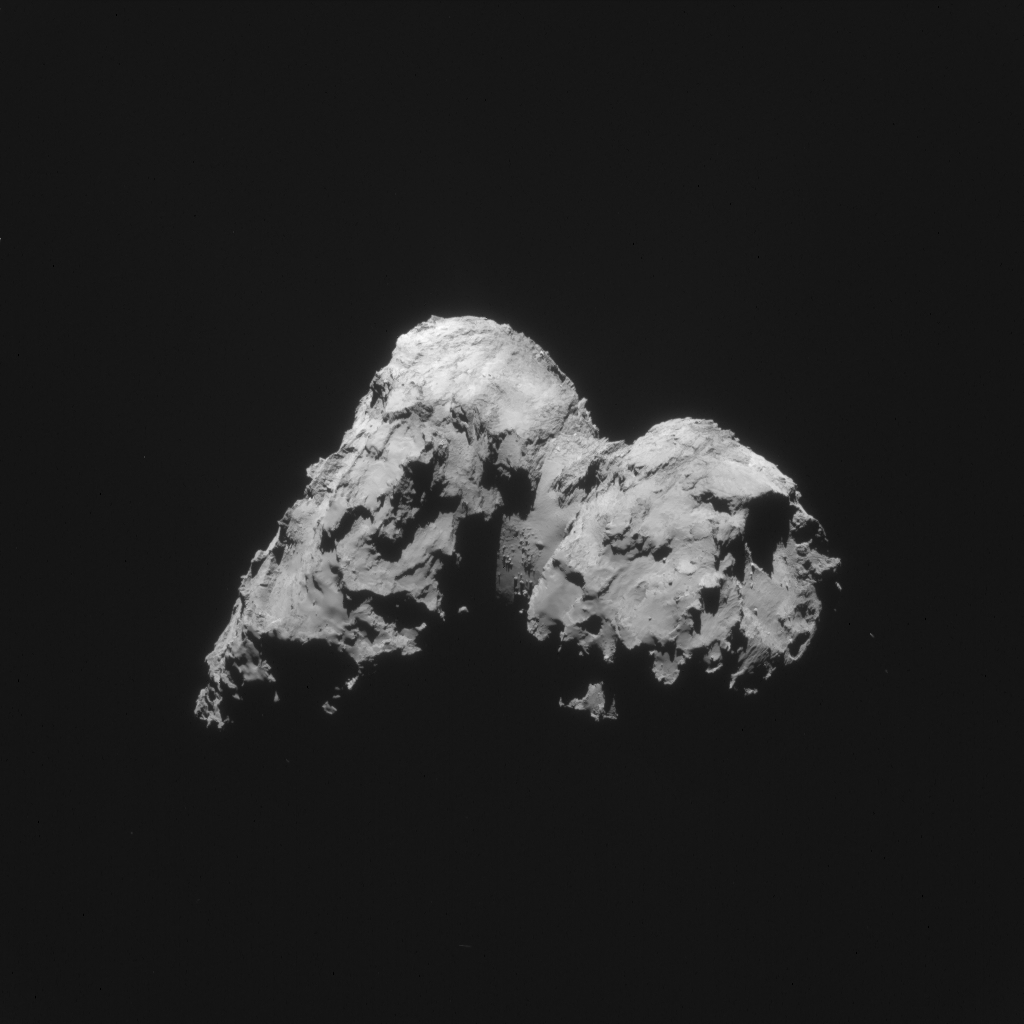Today’s CometWatch features a NAVCAM image taken on 17 January 2016, when Rosetta was 83.4 km from the comet nucleus. The scale is 7.1 m/pixel and the image measures 7.3 km across.

Enhanced NAVCAM image of Comet 67P/C-G taken on 17 January 2016, 83.4 km from the nucleus. Credits: ESA/Rosetta/NAVCAM – CC BY-SA IGO 3.0
The image shows 67P/C-G with the large lobe on the left and the small one on the right, in a similar orientation to that of CometWatch 16 August 2015. In that image, taken only three days after perihelion, the comet’s spectacular activity dominated the view, while today’s image reveals more of the diversity of terrains that are found on the surface.
In the upper part, we see a rough portion of the Khepry region (on the left) and a seemingly smoother portion of Aker (on the right). These two areas were often portrayed in CometWatch entries from April and May 2015, for example in this image from 21 May.
Towards the left edge of the nucleus, this view reveals the narrow and elongated Aten. At the centre of the large lobe is the Babi region, bridging to the dust covered terrains of Ash on the lower left and to Seth, which is almost entirely cast in shadow, on the lower right.
This image also beautifully portrays the string of boulders on the smooth Hapi region, on the ‘neck’ of the comet, leading towards the more rugged Sobek towards the top right.
On the small lobe, we see the rough Bastet region (top) neighbouring smoother portions of Ma’at (bottom). To the right, the large circular depression of Hatmehit is depicted in a striking contrast of bright and shadowed areas that reveal many boulders lying in this region.
You can use the interactive comet viewer tool to explore the various regions of the surface of 67P/C-G.
The original 1024 x 1024 image is provided below.










Discussion: 17 comments
Just as I was comparing all the images I have for possible sources of jet locations seen previously, I received an email from A&A. It pointed me to this paper: “Sunset jets observed on comet 67P/Churyumov-Gerasimenko sustained by subsurface thermal lag.”
X. Shi et al. A&A 586 (Feb 2016)
It’ll be free for seven days after publication. It was published online on the 19th, so be quick. You’ll need to create a free account to access it.
^Should have put a link in the above: https://www.aanda.org/articles/aa/abs…a27123-15.html
$%$%$^!!! Try this one: https://www.aanda.org/articles/aa/abs/2016/02/aa27123-15/aa27123-15.html
Hi Ianw16. It’s not an open document.
It was Logan, but only for a limited time. As I say, a free account is necessary to get these ‘just released’ papers. Best thing to do for anyone interested,is to set up an account, and also sign up to the email notification service. That’s how I managed to get it in time.
From memory, I think there are a couple more I saw in the ‘forthcoming’ section. So once they are released they will be available for ~ a week. Don’t be put off that some of the other articles have ‘open access’ labels above them. That nearly caught me out, but I clicked on the article anyway, and got it no problem. Too late now of course!
Mind you, there are ways of getting paywalled papers, but my comment would never get past moderation if I posted how to do that!
No intent to be incisive, Ianw16. Have read most of your links… But wouldn’t subscribe to a Club having logan as member 😉
Bastet on the neck looks very cracky, just like Anuket on the other side of the equator. Must be a complete coincidence…. Or it could be rocking on the neck, opening cracks straddling the equator on both sides.
Hi Claudia and H. NAVCAM Team:
As far of Ducky shape as She can be:
ROS_CAM1_20150804T000102
https://imagearchives.esac.esa.int/picture.php?/38580/category/168
On a global scale, jetting highly related to the lattice[s] of the Object.
Stress accumulation should also be highly related to the lattice[s].
Hi OSIRIS Team 🙂
More than a beak could be ‘seen’ as the edge of a tool. Suggesting the scenario of a family of jetting meting another angularly. Carving [and patching] a sharp edge.
NAC_2016-01-17T06.55.38.746Z_ID10_1397549500_F22
https://planetgate.mps.mpg.de:8114/Image_of_the_Day/public/OSIRIS_IofD_2016-01-22.html
This is fiction.
See the scars, but can’t see the big piles of debris. First idea is most wasted mass was dismissed from surface.
At this particular perspective and illumination, there are strong clues of what could amount to a single plane going all the way from Imhotep periphery down to conform one of Hatmehit sides. Plausibly related to Emily’s ‘sandwich’ perspective.
https://www.esa.int/spaceinimages/Images/2016/01/Comet_on_17_January_2016_NavCam
That plane 90º to Ducky’s face right side. On a plausible show of Gerald’s commented polyhedral duality.
Logan, yes and three kinds of terrain that match the head to the body from front to back (top to bottom in image):
1. Brighter smooth brittle crust. (Front of ducky’s chest and head)
2. Polyhedral darker boulders surrounded by “lasagna noodles” mid body and head.
3. Flakey turned up “dinosaur fins” down upper back of head and body. (Some hidden in shadow here)
The other side is even more compelling that they are from one body, whether stretched, eroded, or both.
Looking down from the head, (in other Osiris or Navcam views and my own 3D model) the outer border around the head matches a dozen points all around the body shear line in nearly perfect size and shapes. Just too much for coincidence for me. ( I have sent an image to A. Cooper that he may use in his or Marco P.’s blog for that top view.)
I strongly suggest to anyone who is really serious about visualizing 67p, you really should have a 3D model made to hold and play with as I did… It was so easy!
I simply made a phone call to my local UPS shipping store, (yes that UPS!) and was referred to the store guy who does this. Then simply emailed the link to Mattias Malmer’s latest shape model, (which is better than ESA’s at this time). For about $75 USD for a 2×3″ model, they will 3d print it in color of your choice and mail it to you!
This was a vastly entertaining and easy thing to have done!
Suggest going up in size to say 2.5″ x 3.75″ for even more detail and easier handling, possibly for about $100 USD.
I had three made for $68 each for purposes that will be revealed in more detail later. The white one will have the color map of regions applied, a blue one will be molded and cut up for visualizing various formation scenarios, and the dark grey one remains intact as is, for just playing and visualizing.
There is no better thing than holding it under a point source light and turning it over in your hand to control lighting and viewing angles! Even to study spin at pre and post perhelion for thinking about erosion and thermal tides, whatever. A must… in my opinion!
Hope others make this relatively small investment themselves and be prepared to also have their “eyes opened”.
Thanks!
Sounds like you are having fun, Benson 🙂 I will wait for videos of H. Malmer models including latest libraries.
Emily [and Marco and Cooper] have also been following skin texture for some time. [Which says a lot of subsurface activity, also].
Eagerly awaiting for Teams on a preliminary study on thermal tides. Something doesn’t “add up”. Heating is so profound… Anyway.
Congratulations on your physical models! Obvious is you are a real explorer 🙂
Thanks Logan!
Well I was Ramcomet, guess I logged in with my real name now. Oops!
Hi Rambo,
Works for me. 🙂